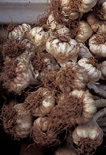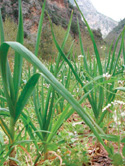

Garlic has an ancient history.
REGARDING GARLIC, BOTH THE Quran and the Bible refer to the same incident—when people complained to Moses about food as they traveled in the wilderness: “O Moses, we are tired of eating the same food, ask your Lord to give us fruits of the earth, herbs and cucumbers, grains and lentils and onions” (Sura 2:61, Ali); and, “We remember the fish that we ate in Egypt for nothing; the cucumbers, and the melons, and the leeks, and the onions, and the garlic” (Numbers 11:5, JND). Any visitor to Egypt knows that garlic, Allium sativum, is still one of the most widely used flavorings in food in that country.
Garlic is linked with onion, both in the scriptures and in grocery stores, but there are significant differences in their biology. First, garlic is sterile and must be planted from bulbs. The structure of the bulb is much different in onion and garlic. The onion bulb consists of overlapping scale leaves while the garlic bulb is formed from the thickened leaf bases that develop within a common covering. There is considerable evidence that garlic was widespread in the ancient Middle East (Mathew 1996, Zohary and Hopf 2000).
Garlic is an example of a hapax legomenon, a Greek term for something mentioned only once, in the Bible. This fact is striking, since garlic was used extensively at the time the biblical verse was written. And further evidence is provided by the ubiquitous traditional use of garlic today in foods of the entire Mediterranean region.
Garlic drying in a window in Hama, Syria.

Field of garlic in February, in Wadi Jhhanem, Lebanon. The bulbs were planted in the winter and will be harvested in the spring.